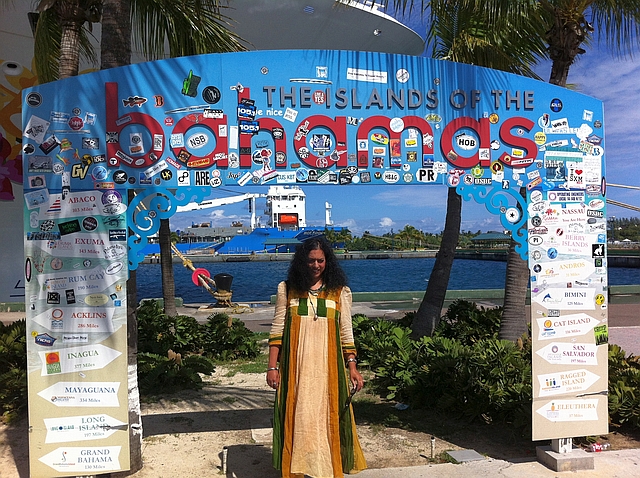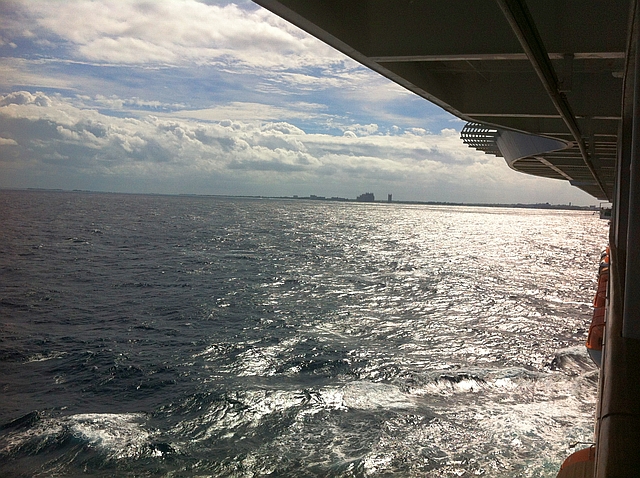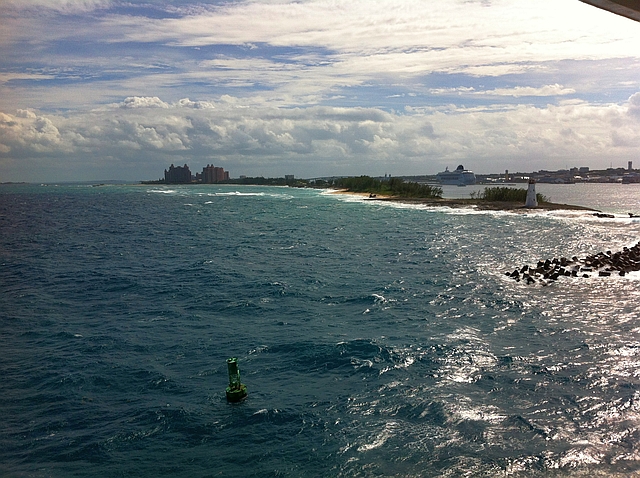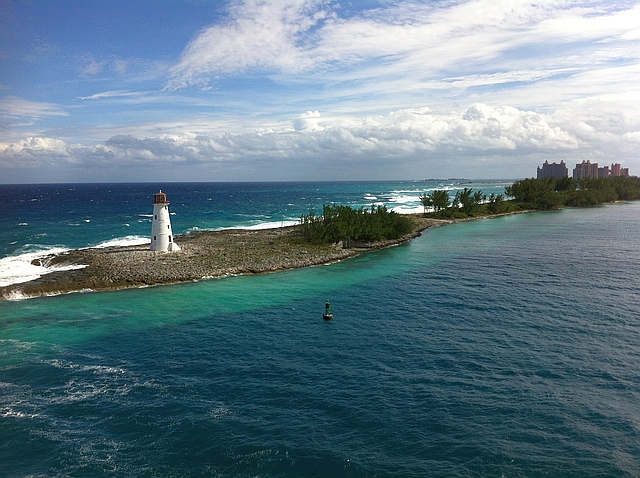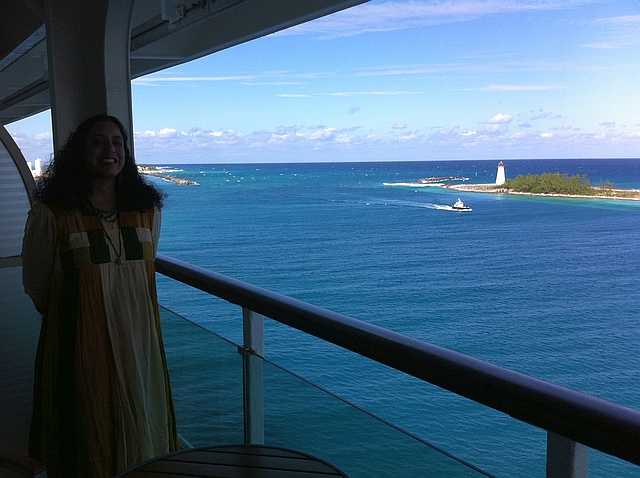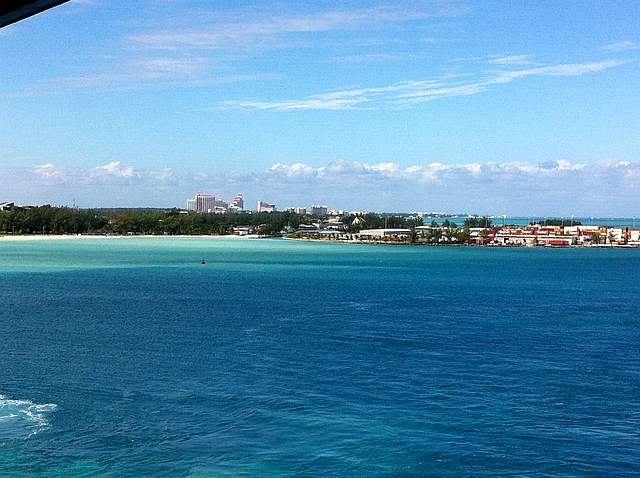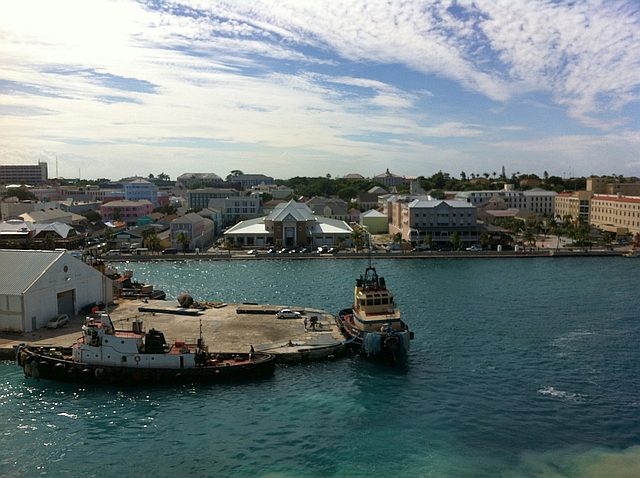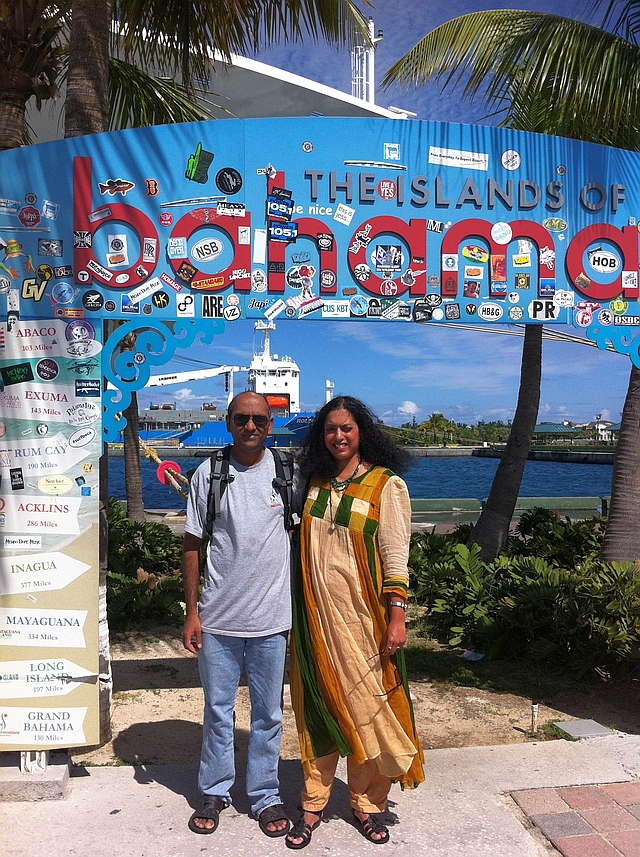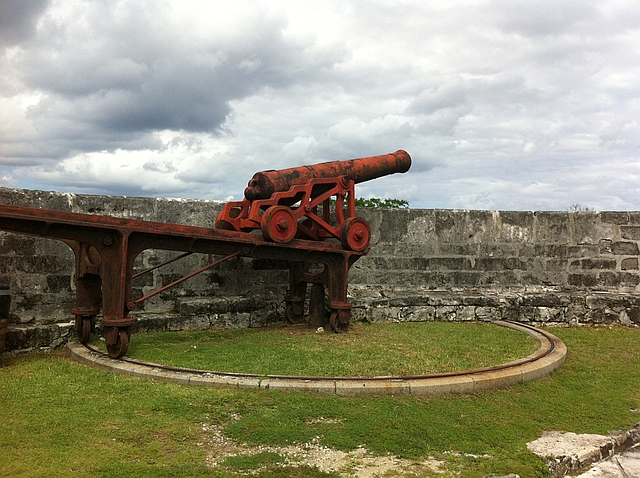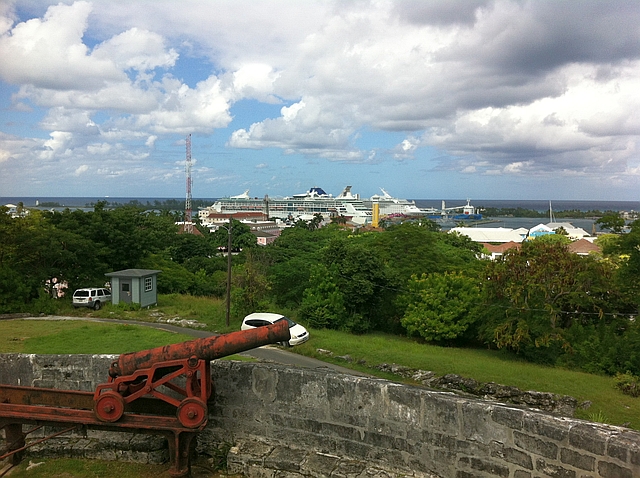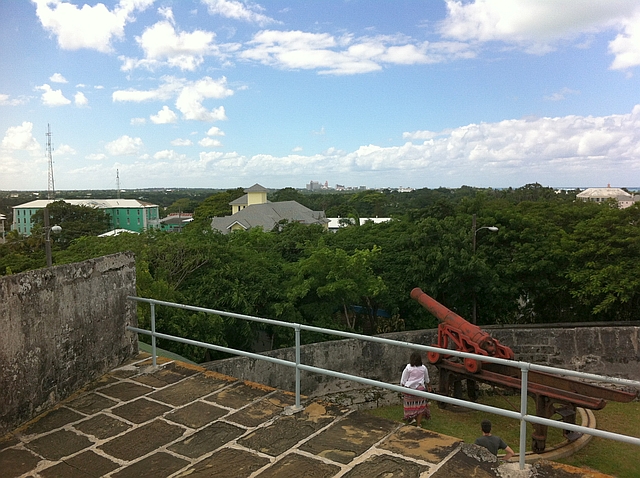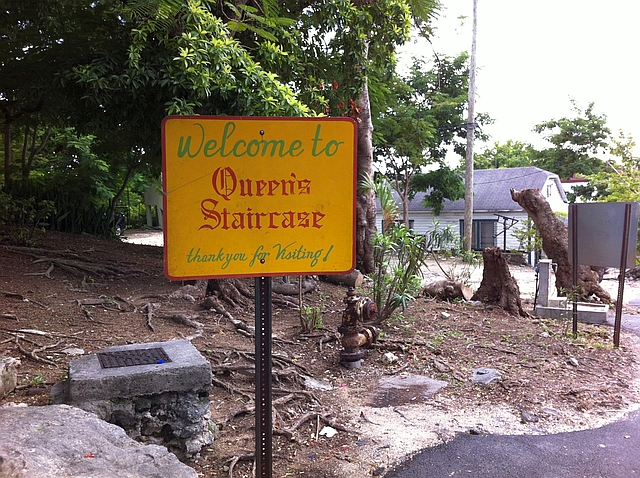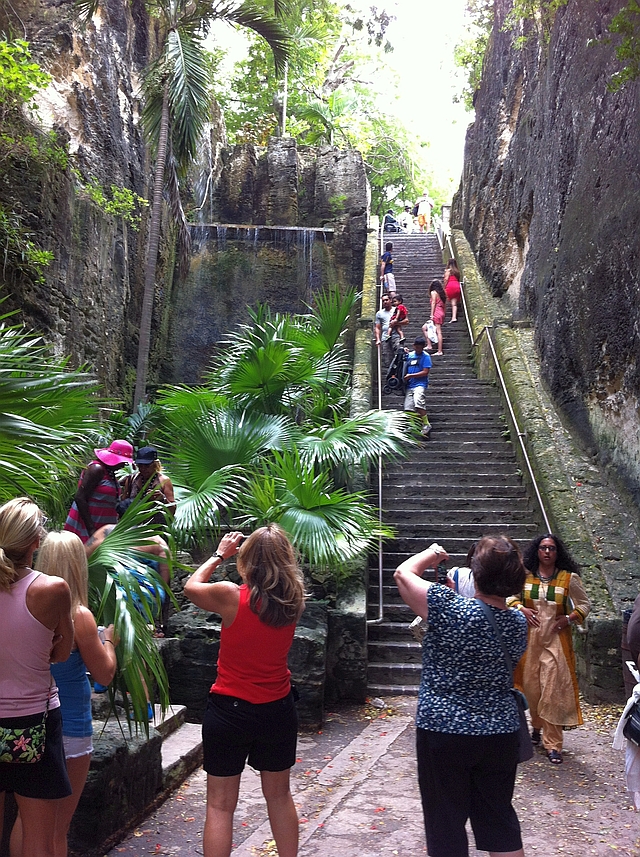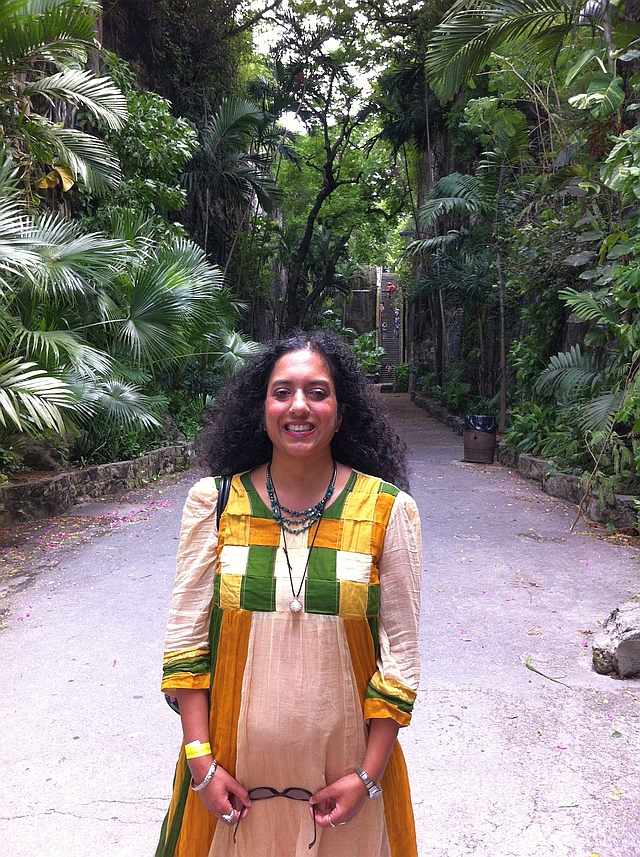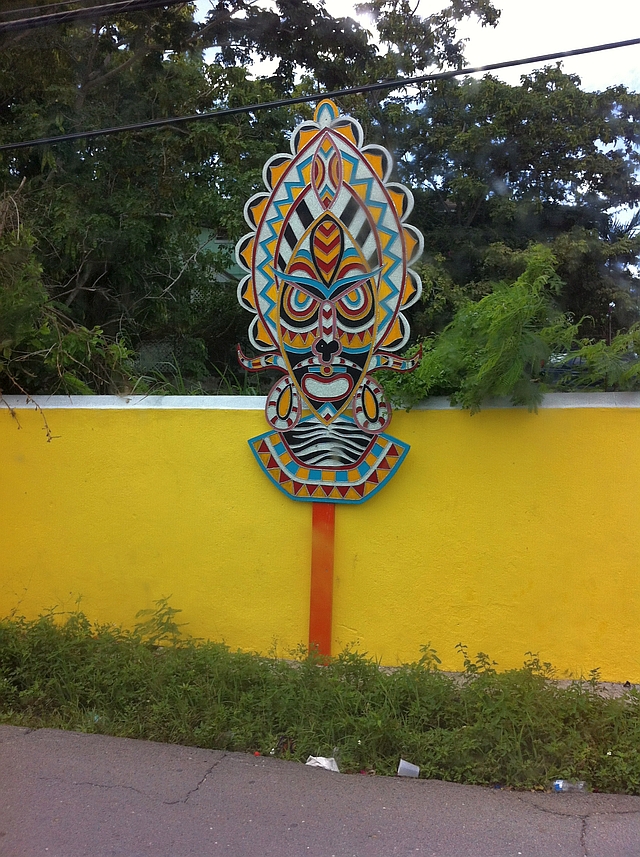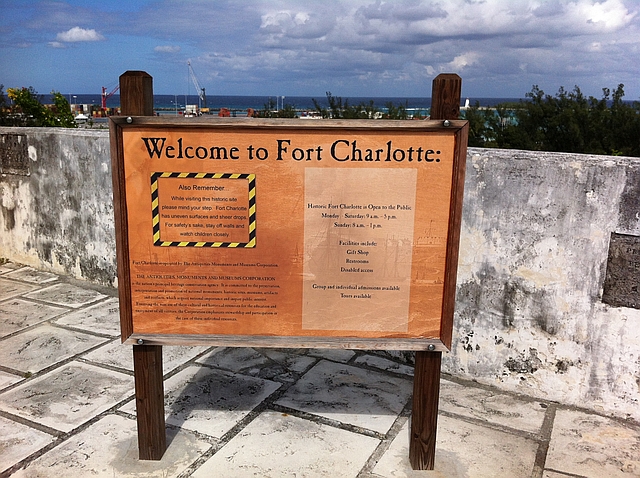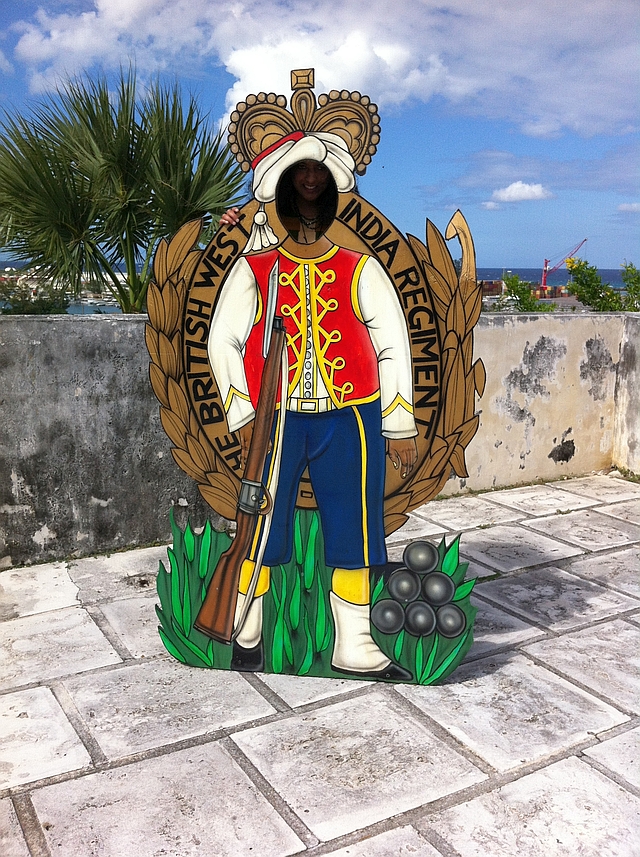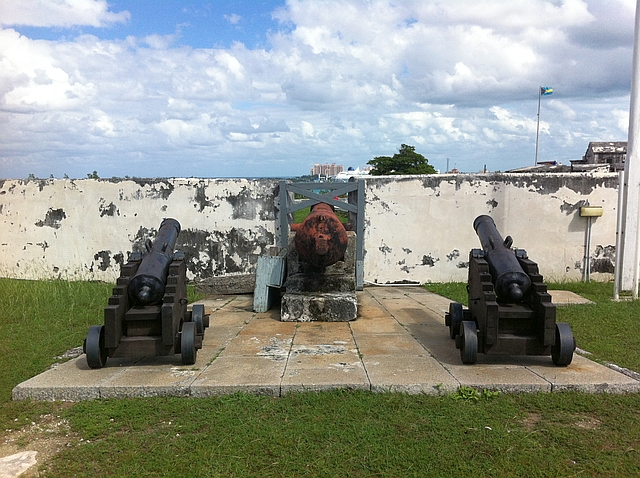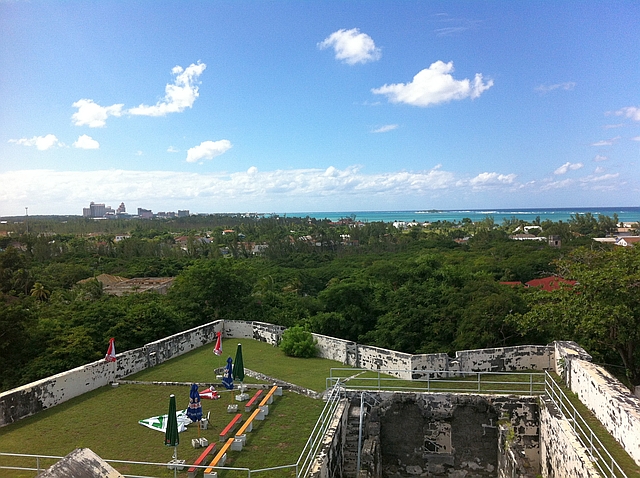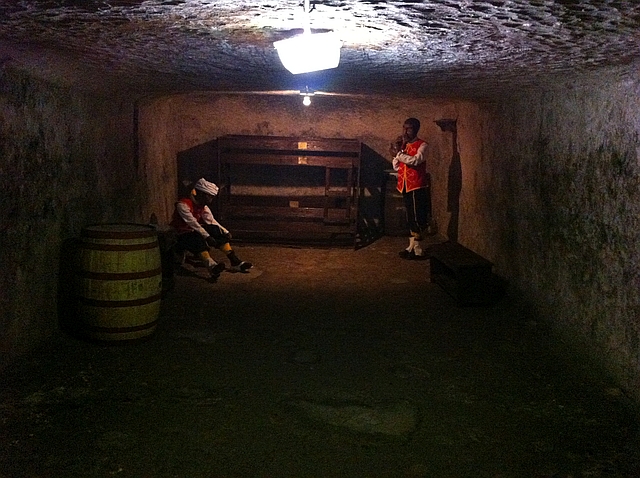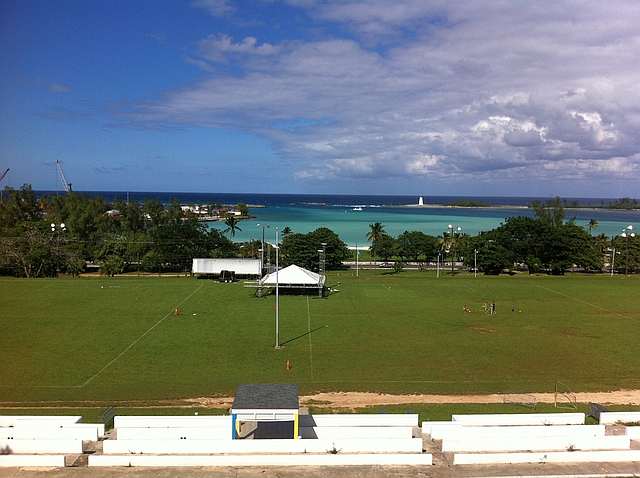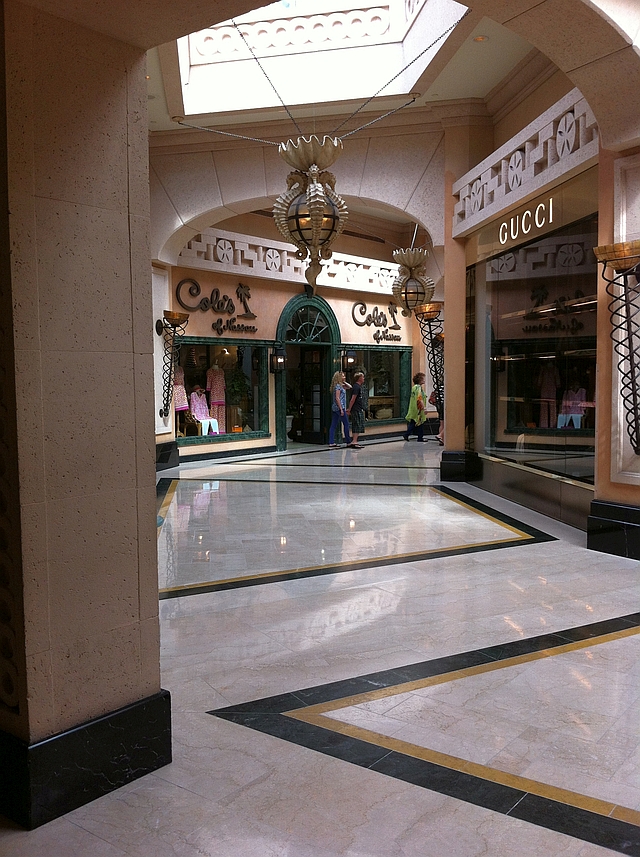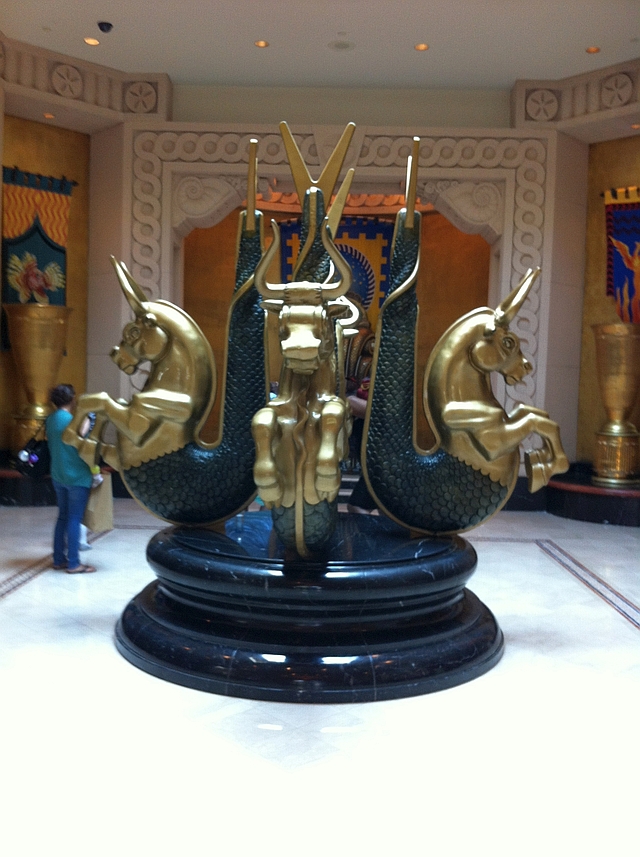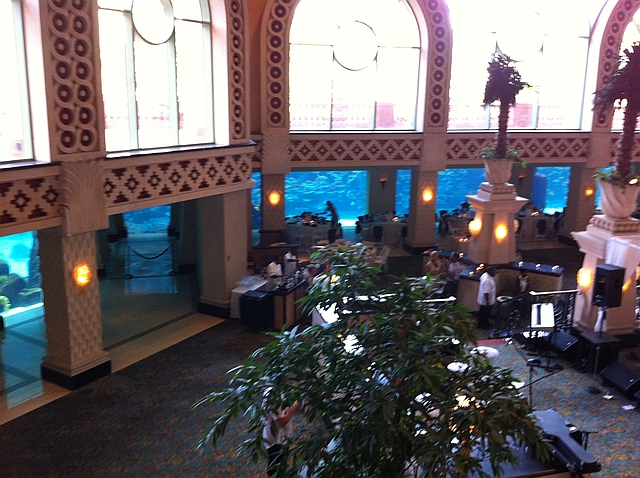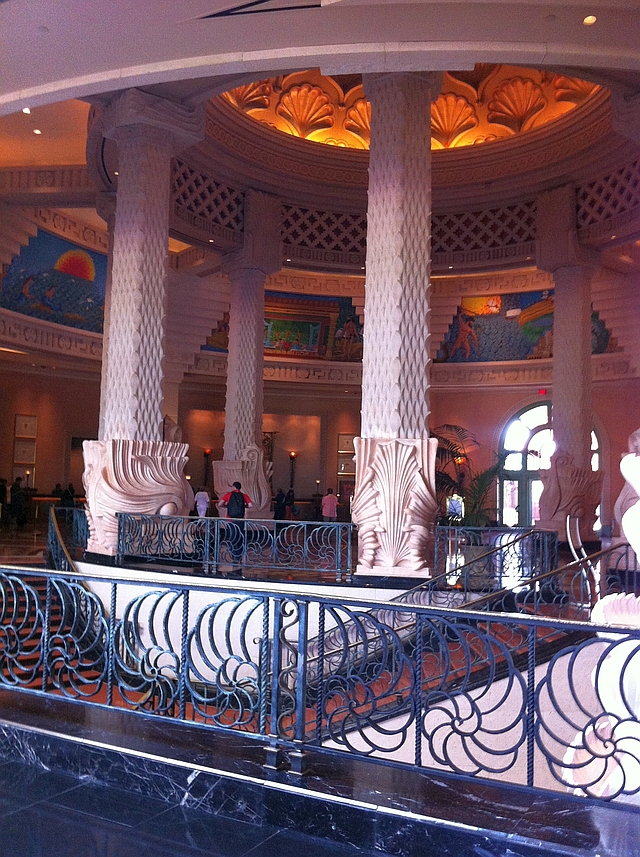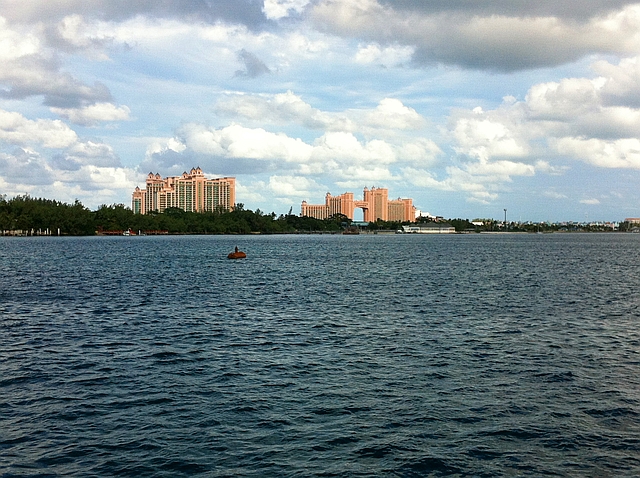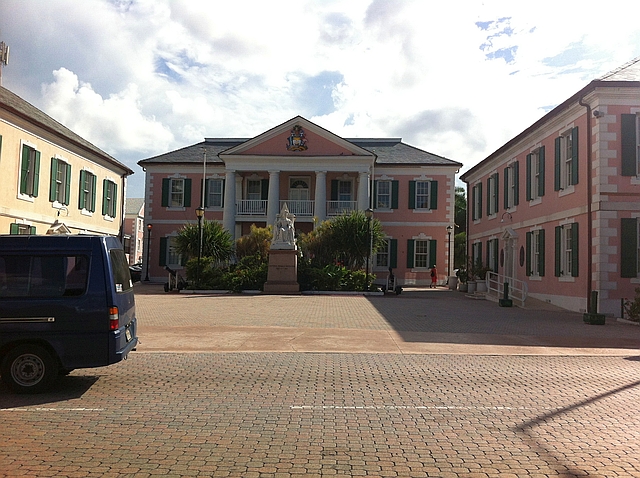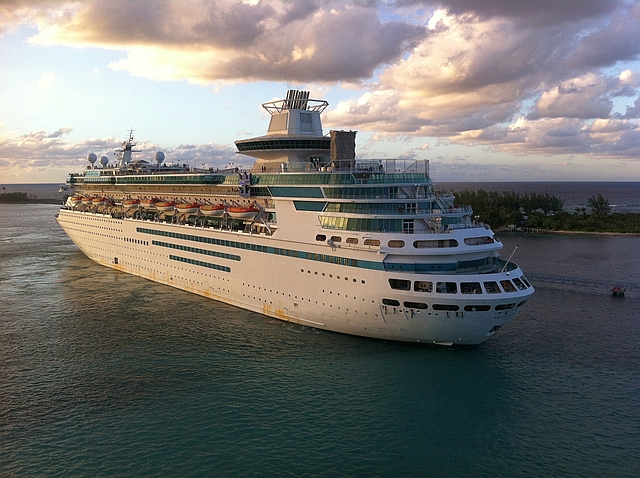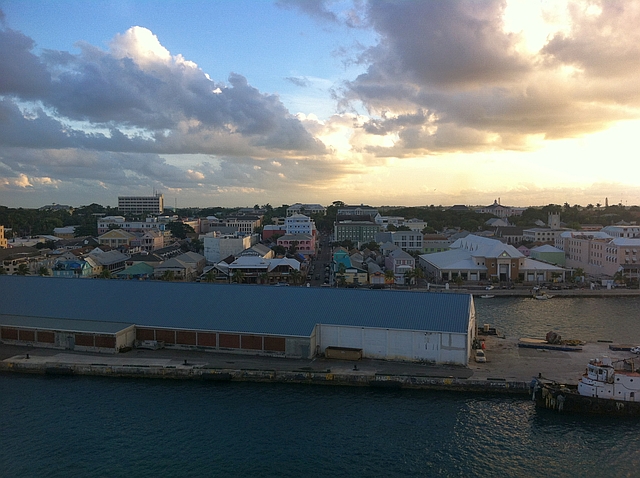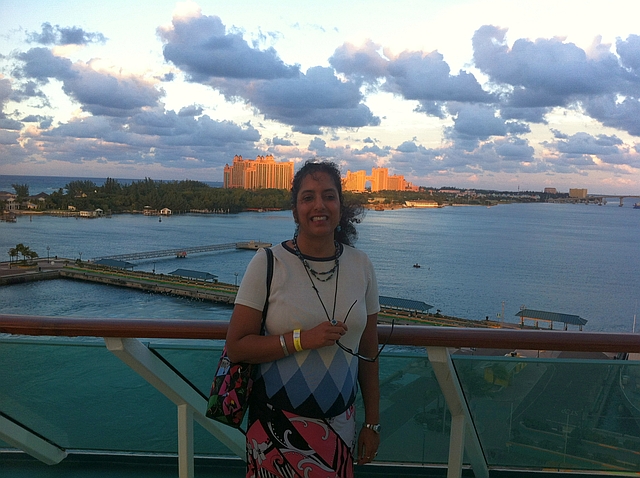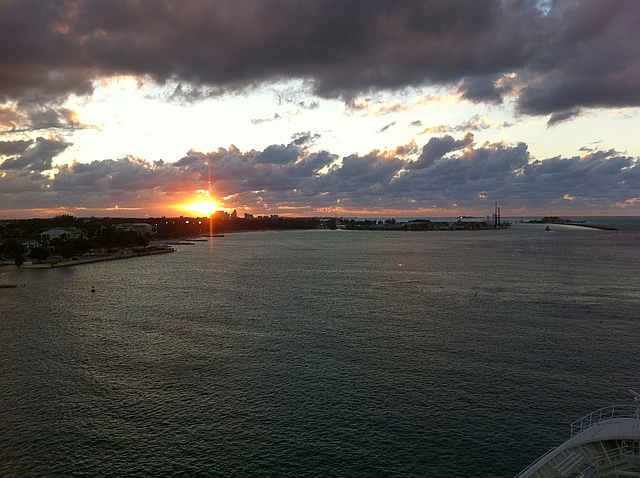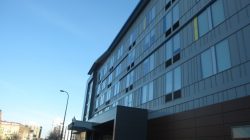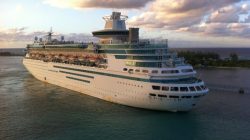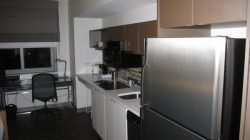The latest addition to the welcome sign gallery
One reason I like cruises is the opportunity to sample a variety of different ports during a single itinerary. Sure, you don’t usually have enough time to explore a port in depth (with a few exceptions – cruises to Bermuda in particular), but I look at it as a way to get a bite-sized sample of a place without going whole hog with a week’s vacation, with the opportunity to go back again later if the destination proves to be a hit. Such was the case with the Bahamas, our destination on our cruise from Port Canaveral, Florida that I reviewed last week. I had actually heard mixed reviews about the Bahamas, and Nassau in particular. Thus, a “drive by” type of visit had additional appeal.
The Islands of the Bahamas constitute an archipelago of more than 700 individual islands, extending from Grand Bahama Island in the north to the Turks & Caicos in the south and surrounded by the world’s third largest barrier reef system. The Bahamas are also the nearest of the island chains to the mainland United States; Bimini sits just 50 miles east of Miami. From Port Canaveral, Freeport is approximately 180 miles, and Nassau a little over 300. If you decide to visit these islands, you’ll be delighted to know that there are numerous Staniel Cay Day Attractions you can enjoy. You may also book a boat charter rental to visit different islands.
Historians believe that native Lucayan Indians inhabited the islands as early as the 4th-5th century. What really cemented the islands’ place in history, though, was Columbus’ landing on San Salvador island in 1492. Puritans first settled here in the mid-17th century, though the Bahamas quickly became famous (or infamous) for another reason – piracy. The sheer number of islands made it easy for privateers and pirates to hide and hard to catch.
The Bahamas endured numerous boom and bust cycles based on its trading/commodities economy over the ensuring centuries. Perhaps the most devastating cycle occurring during America’s brief experiment with Prohibition. The islands enjoyed a spectacular boom as a haven for alcohol smuggling. But that busted just as spectacularly once Prohibition ended. Eventually, though, the islands recovered as a haven for tourism, especially after Castro’s takeover of Cuba. With American tourists no longer allowed, they flocked to the beaches of the Bahamas instead. Today, the Bahamas are well-known for the islands’ all-inclusive beach resorts, destination weddings, and as a cruise ship destination.
Given the short distance from Florida, even at the leisurely pace of a cruise ship, you approach New Providence Island and Nassau by about 11 A.M. the next day (you actually pass by Freeport in the wee hours of the morning). Approaching Nassau from the north, the first thing you see is the sprawling Atlantis resort, on the adjacent Paradise Island. As the approach continues, you begin to see the colorful shallow shoals and reefs that surround the Bahamian islands. You also see a lighthouse on the end of Paradise Island that marks the entrance to Nassau’s harbor.
You’ll also notice the picture perfect weather that accompanied our arrival. We nervously watched the weather for a week. The experts predicted a complete washout on Saturday due to a possible tropical low. Thankfully, the front blew through a day early, leaving us with a delightful sunny day. (Note to readers: as a geography geek, a good part of the fun in visiting a place by ship is the approach. That’s why you’ll see a picture show of the approach before I get into the review of the port itself in all of my posts. If you’re looking for port information only, skip the next few paragraphs.)
After you pass by the lighthouse, look aft to see just how narrow the passage is into the harbor; this contributed heavily to the susceptibility of arriving ships to pirate attacks. Fortunately, modern technology makes this an easy trip today. In the second photo, the cargo area is Arawak Cay; the large buildings further away on the left are part of a large resort complex featuring the Baha Mar Resort & Casino, the Grand Hyatt, and the Wyndham Nassau Resort, among others.
And finally, we docked at our assigned spot in the harbor. The shopping director told us that the port of Nassau can handle up to 7(!) cruise ships at a time. But today, it was only us and one other ship (not pictured, as it is on the opposite side). Downtown Nassau sports the colorful British Colonial architecture that is typical of the Caribbean islands. The Islands of the Bahamas were also kind enough to put up a welcome sign for tourists to pose with. The lady who kindly offered to take our picture together cut off the sign. You can see the full version at the top of this post, though.
Our ship wasn’t scheduled to depart until midnight, but with a limited amount (about 6 hours) of daylight for touring, we had a tight schedule. We decided to purchase a tour from the cruise line to look around the city. Then, we walked around downtown afterwards to look for junk and, most importantly, some rum and a rum cake. Our tour first took us to Fort Fincastle, built in 1793 on Bennett’s Hill to defend the entrance to the harbor. You can actually walk here from the cruise ships if you want to; it is only about a 10-20 minute walk from the harbor.
This is a small fort, with only a few battery stations and a small storehouse. But it’s still worth seeing if you are in Nassau. The top of the fort also provides nice views of the city and the harbor. Admission to the fort is $1 per person, and there are vendors outside selling various trinkets. You’ll get a better selection of stuff downtown, though. CAUTION: while guides offer tours, they won’t mention the aggressive shakedown for tips afterwards. This is a common theme throughout the Bahamas, so if you want to take the guided tour, keep some dollar bills with you.
Next door to Fort Fincastle is the Queen’s Staircase. The staircase was carved out of the solid limestone hill by slaves between 1793 and 1794, and was intended as a shortcut from Fort Fincastle to downtown Nassau. The staircase originally contained 66 steps, but today, you’ll only count 65. This is because a paving project covered up the bottom stair years ago. As you exit the path, you’ll find yourself next to the Princess Margaret Hospital parking lot. From here, it is only a few minutes’ walk back to downtown.
The route to the staircase from Fort Fincastle isn’t clearly marked, but it is easy enough to find; go straight along the path through the vendor stalls, turn right at the street, and you’ll see the sign for the staircase a few feet down the road. The staircase, while a bit steep, isn’t that daunting a challenge as long as you’re in decent shape. However, use caution when it is raining, as the steps become quite slippery when wet. There is also an artificial waterfall to the left of the staircase as you are going up. From the far end, you almost feel as though you are in the islands’ original tropical rain forest.
After visiting the fort and the staircase, we headed west to our next stop, Fort Charlotte, on a high ridge overlooking the city off of West Bay Street. On the way, I spotted this interesting sculpture on the side of the road.
According to our tour guide, this is a mask that replicates those used by the native Indian tribes in ceremonies used to ward off evil spirits. Maybe they could stick one of these in front of the hideous Eye sculpture downtown and have it self-destruct…anyway, back to Fort Charlotte. The fort took 32 years to build, with construction completed in 1819. What is today known as a single “Fort Charlotte” is actually three separate installations – Fort Charlotte, the eastern section; Fort Stanley, the center section; and Fort D’Arcy, the western section. Fort Charlotte is a bit more complete of an experience than Fort Fincastle. In addition to the larger grounds, it contains a series of interpretive exhibits detailing the history of the fort. And of course, visitors are provided outstanding views of the surrounding area.
Welcome sign at the entrance to the fort
Cheesy photo op for the kids
A rather humorous shot – artillery guns pointed at our ship and the Atlantis resort
View to the west of the fort
Example of an interior storage room
View to the north of the entrance to the harbor and the Paradise Island lighthouse
The link above indicates an admission fee of $5 per person, but when we went, we were only charged $2; it may vary by season. As with Fort Fincastle, guided tours are offered, but your guide will expect a tip at the tour’s conclusion. If you don’t come as part of a city tour, you can probably walk here from the city in 20-30 minutes, so save yourself the cab fare.
After 20 minutes or so at the fort, we then headed back east through downtown to our final stop of the day at Paradise Island and the well-known Atlantis resort. If you’re even a casual flyer, you’ll no doubt recognize Atlantis from the advertisements in the inflight magazine. At least it used to feature prominently in American Way. Atlantis has your typical, sprawling hotel and casino complex, high-end retail, and omnipresent private beach areas. But Atlantis tries to set itself apart with its unique guest experiences, including a dolphin swim encounter, an on-site water park, and its underwater restaurants and public areas. Perhaps its most over-the-top feature, though, is the “Michael Jackson” suite. It’s available at the low, low price of $25,000 per night with a 4-night minimum.
Retail shops way out of my price range
Sculpture in a public area
Underwater public area, where you can get up close and personal with the reef
Ornate decorations in public areas
View of the entire complex; the Michael Jackson Suite is the seemingly suspended walkway between the two halves of the building on the right
Most ship tours that make quick stops at Atlantis give you the option of staying at the resort and returning at your leisure later by taxi. About half of our group chose to do so, mainly to enjoy the large casino it seemed (they actually still have 3-2, $5 minimum blackjack if that’s your game). If you do decide to stay, to return to downtown, you can take the ferry for $4 each way, or a taxi for around $11. If using a taxi, remember that cabs here are not metered, so negotiate the fare with the driver up front. Or you can try and walk, but 1) it’s a pretty good haul, and will probably take around an hour, and 2) the route along Bay Street goes through a rather sketchy area, and appears as though it may be unsafe at night.
We decided not to stay at Atlantis, and headed back to downtown to look for junk. My wife wanted to go to the Nassau Straw Market on Bay Street, so that’s where we headed. At first glance, the market seems a tad out of place; it’s surrounded by high-end retail shops selling watches and jewelry, as you find at pretty much every cruise port. At the Straw Market, though, you come for cheap trinkets, with each stall owned by a different person but selling essentially the same stuff. Think dresses, mugs, wood carvings, costume jewelry, etc.
One very important thing if you visit the Straw Market – all prices are negotiable, and in fact, it’s critical to bargain before your stall owner rings up your purchase. The more you buy, generally the larger a discount you can get. Start off with what you think is fair obviously, but I’d suggest starting off somewhere between a third an a half off of what the stall owner first tells you. My wife having picked up her fill of trinkets, I did pick up what I wanted on the way back, a rum cake and a liter of Tortuga rum.
I forgot to take a photo of the Straw Market, but this is a typical colonial building downtown
Honestly, I found downtown Nassau kind of lame. There’s plenty of stuff to buy, but it looks pretty run down, an having to deal constantly with hawkers (and the smell of weed) gets tiresome. With only a couple of hours of daylight left anyway, we decided to head back to the ship, and enjoy sunset from the observation deck on Deck 10.
Another RCCL ship, the Monarch of the Seas, which we sailed on back in 1997
Downtown Nassau in the fading light
A glowing Atlantis thanks to the sun angle
And finally, the sun setting over the resort complex west of Nassau
Overall thoughts: Nassau reminded me of our visit to Montego Bay, Jamaica. The city itself is pretty ratty and run-down, and the constant hawking is irritating. I doubt we’d come back to Nassau just to visit the city. But I wish we had more time to explore the outlying areas. Even on New Providence Island, there are a couple of lakes/lagoons west of the city that might be interesting to see, and the beaches did look fantastic. I’d come back to the Bahamas, just not to the city itself.
Other Miscellaneous Information
– Currency – Bahamian dollar, but as its value is pegged to par with the US dollar, Greenbacks are accepted everywhere. Save yourself the foreign exchange fees at the ATM, and just grab some cash in Florida before you leave.
– Food – we didn’t stay long enough to sample Bahamian cuisine, but what you’ll find is generally similar to Caribbean islands. Not surprisingly, the Bahamas are a haven for fresh seafood lovers. Conch, especially a type of conch ceviche, is a Bahamian specialty, along with fresh fish, rock lobster, and land crabs; dishes are frequently accompanied by another Caribbean mainstay, peas and rice. There is a heavy British influence as you’d expect, but there’s also a heavy dose of the robust flavors and spices of the Caribbean. If you’re in to hot sauce, many craft shops will sell you a bottle.
– Transportation – in Nassau and Freeport, taxis and city buses are readily available at pretty much any time. Remember that if you decide to hail a cab, negotiate the fare BEFORE you get in, as taxis in the Bahamas are not metered. You can rent a vehicle at the Freeport and Nassau airports, but I would strongly discourage trying to drive in the Bahamas. Besides the adjustment period of driving on the left side of the road, as is the case with too many of the Caribbean islands, roads are narrow and often in poor condition, and traffic rules tend to be inconsistently followed. Avoid driving at night at all costs.
If you don’t want to take a cruise ship to the Bahamas, all major U.S. airlines operate flights to Freeport, Nassau, and Grand Turk. All three are a very short flight from Miami; just beware that you will be flying on a regional jet, if not a turboprop.
– Climate – basically a carbon copy of South Florida, which is to say very warm, very humid, and very wet during the rainy season, which generally coincides with hurricane season. Fall and winter are pleasant and less humid; we enjoyed a sunny day with a high in the low-80s during our visit. You can find some pretty good deals and thinner crowds during hurricane season, but the drawback is 1) it rains a lot, and 2) there is always the risk that your trip could be interrupted or canceled by a tropical system. I’d personally suggest going between late October and early December, when the threat of hurricanes is lower (though non-zero), but the winter crowds haven’t shown up yet.
– Other – as I’ve mentioned a couple of time already, hawkers and touts demanding tips for their assistance are an irritation, similar to what I experienced in Jamaica on a cruise several years ago. Be especially careful with taxi touts, who are only more than happy to take advantage of tourists unaware that prices can be negotiated, and who’ll likely stick you with an unwanted visit to a store en route. Also remember that since this is the Bahamas, everything is in English; you don’t have to hire a guide to explain things to you.

